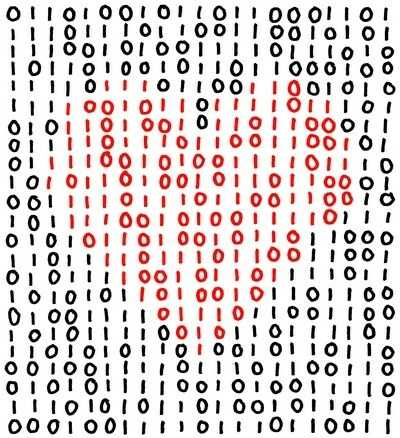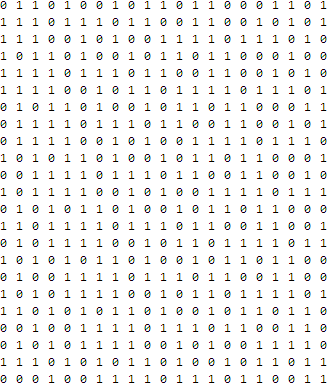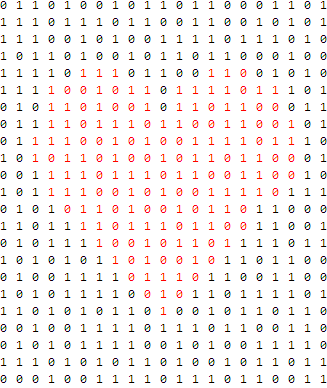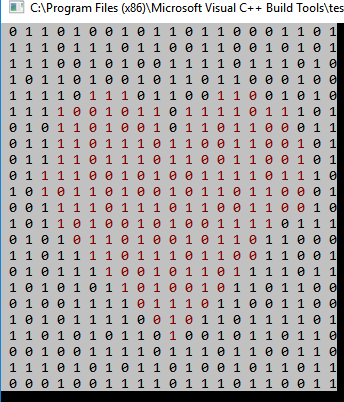58
10
XKCD #99, with the title "Binary Heart" shows a simple image of ones and zeros, with some digits colored red.
The red heart is visible to the naked eye, but the message hidden in the binary sequence is not. If you remove all the spaces and newlines and interpret the binary sequence as 8 bit ASCII-code, you'll end up with the message:
iloveyOuilOveyouiloveyOuilOveyOuiloveyouilOveyouilOveyOuilOv
Cute right?
Pssst... The string isn't a pure string repetition.
Your challenge is to create this binary image with 21 digits across, and 23 digits down. There should be exactly one space between each digit in each row, and one newline for each new row. Note that the last bits are only the beginning of the letter e, since 21*23 isn't divisible by 8. You need those bits correct too.
The function or program should not take any input. Leading and trailing spaces and newlines are accepted.
The result of your code should look like this:
0 1 1 0 1 0 0 1 0 1 1 0 1 1 0 0 0 1 1 0 1
1 1 1 0 1 1 1 0 1 1 0 0 1 1 0 0 1 0 1 0 1
1 1 1 0 0 1 0 1 0 0 1 1 1 1 0 1 1 1 0 1 0
1 0 1 1 0 1 0 0 1 0 1 1 0 1 1 0 0 0 1 0 0
1 1 1 1 0 1 1 1 0 1 1 0 0 1 1 0 0 1 0 1 0
1 1 1 1 0 0 1 0 1 1 0 1 1 1 1 0 1 1 1 0 1
0 1 0 1 1 0 1 0 0 1 0 1 1 0 1 1 0 0 0 1 1
0 1 1 1 1 0 1 1 1 0 1 1 0 0 1 1 0 0 1 0 1
0 1 1 1 1 0 0 1 0 1 0 0 1 1 1 1 0 1 1 1 0
1 0 1 0 1 1 0 1 0 0 1 0 1 1 0 1 1 0 0 0 1
0 0 1 1 1 1 0 1 1 1 0 1 1 0 0 1 1 0 0 1 0
1 0 1 1 1 1 0 0 1 0 1 0 0 1 1 1 1 0 1 1 1
0 1 0 1 0 1 1 0 1 0 0 1 0 1 1 0 1 1 0 0 0
1 1 0 1 1 1 1 0 1 1 1 0 1 1 0 0 1 1 0 0 1
0 1 0 1 1 1 1 0 0 1 0 1 1 0 1 1 1 1 0 1 1
1 0 1 0 1 0 1 1 0 1 0 0 1 0 1 1 0 1 1 0 0
0 1 0 0 1 1 1 1 0 1 1 1 0 1 1 0 0 1 1 0 0
1 0 1 0 1 1 1 1 0 0 1 0 1 1 0 1 1 1 1 0 1
1 1 0 1 0 1 0 1 1 0 1 0 0 1 0 1 1 0 1 1 0
0 0 1 0 0 1 1 1 1 0 1 1 1 0 1 1 0 0 1 1 0
0 1 0 1 0 1 1 1 1 0 0 1 0 1 0 0 1 1 1 1 0
1 1 1 0 1 0 1 0 1 1 0 1 0 0 1 0 1 1 0 1 1
0 0 0 1 0 0 1 1 1 1 0 1 1 1 0 1 1 0 0 1 1
This is code golf, so the shortest answer (in bytes) wins.
Leaderboard
var QUESTION_ID=94699,OVERRIDE_USER=31516;function answersUrl(e){return"https://api.stackexchange.com/2.2/questions/"+QUESTION_ID+"/answers?page="+e+"&pagesize=100&order=desc&sort=creation&site=codegolf&filter="+ANSWER_FILTER}function commentUrl(e,s){return"https://api.stackexchange.com/2.2/answers/"+s.join(";")+"/comments?page="+e+"&pagesize=100&order=desc&sort=creation&site=codegolf&filter="+COMMENT_FILTER}function getAnswers(){jQuery.ajax({url:answersUrl(answer_page++),method:"get",dataType:"jsonp",crossDomain:!0,success:function(e){answers.push.apply(answers,e.items),answers_hash=[],answer_ids=[],e.items.forEach(function(e){e.comments=[];var s=+e.share_link.match(/\d+/);answer_ids.push(s),answers_hash[s]=e}),e.has_more||(more_answers=!1),comment_page=1,getComments()}})}function getComments(){jQuery.ajax({url:commentUrl(comment_page++,answer_ids),method:"get",dataType:"jsonp",crossDomain:!0,success:function(e){e.items.forEach(function(e){e.owner.user_id===OVERRIDE_USER&&answers_hash[e.post_id].comments.push(e)}),e.has_more?getComments():more_answers?getAnswers():process()}})}function getAuthorName(e){return e.owner.display_name}function process(){var e=[];answers.forEach(function(s){var r=s.body;s.comments.forEach(function(e){OVERRIDE_REG.test(e.body)&&(r="<h1>"+e.body.replace(OVERRIDE_REG,"")+"</h1>")});var a=r.match(SCORE_REG);a&&e.push({user:getAuthorName(s),size:+a[2],language:a[1],link:s.share_link})}),e.sort(function(e,s){var r=e.size,a=s.size;return r-a});var s={},r=1,a=null,n=1;e.forEach(function(e){e.size!=a&&(n=r),a=e.size,++r;var t=jQuery("#answer-template").html();t=t.replace("{{PLACE}}",n+".").replace("{{NAME}}",e.user).replace("{{LANGUAGE}}",e.language).replace("{{SIZE}}",e.size).replace("{{LINK}}",e.link),t=jQuery(t),jQuery("#answers").append(t);var o=e.language;/<a/.test(o)&&(o=jQuery(o).text()),s[o]=s[o]||{lang:e.language,user:e.user,size:e.size,link:e.link}});var t=[];for(var o in s)s.hasOwnProperty(o)&&t.push(s[o]);t.sort(function(e,s){return e.lang>s.lang?1:e.lang<s.lang?-1:0});for(var c=0;c<t.length;++c){var i=jQuery("#language-template").html(),o=t[c];i=i.replace("{{LANGUAGE}}",o.lang).replace("{{NAME}}",o.user).replace("{{SIZE}}",o.size).replace("{{LINK}}",o.link),i=jQuery(i),jQuery("#languages").append(i)}}var ANSWER_FILTER="!t)IWYnsLAZle2tQ3KqrVveCRJfxcRLe",COMMENT_FILTER="!)Q2B_A2kjfAiU78X(md6BoYk",answers=[],answers_hash,answer_ids,answer_page=1,more_answers=!0,comment_page;getAnswers();var SCORE_REG=/<h\d>\s*([^\n,]*[^\s,]),.*?(\d+)(?=[^\n\d<>]*(?:<(?:s>[^\n<>]*<\/s>|[^\n<>]+>)[^\n\d<>]*)*<\/h\d>)/,OVERRIDE_REG=/^Override\s*header:\s*/i;body{text-align:left!important}#answer-list,#language-list{padding:10px;width:290px;float:left}table thead{font-weight:700}table td{padding:5px}<script src="https://ajax.googleapis.com/ajax/libs/jquery/2.1.1/jquery.min.js"></script> <link rel="stylesheet" type="text/css" href="//cdn.sstatic.net/codegolf/all.css?v=83c949450c8b"> <div id="answer-list"> <h2>Leaderboard</h2> <table class="answer-list"> <thead> <tr><td></td><td>Author</td><td>Language</td><td>Size</td></tr></thead> <tbody id="answers"> </tbody> </table> </div><div id="language-list"> <h2>Winners by Language</h2> <table class="language-list"> <thead> <tr><td>Language</td><td>User</td><td>Score</td></tr></thead> <tbody id="languages"> </tbody> </table> </div><table style="display: none"> <tbody id="answer-template"> <tr><td>{{PLACE}}</td><td>{{NAME}}</td><td>{{LANGUAGE}}</td><td>{{SIZE}}</td><td><a href="{{LINK}}">Link</a></td></tr></tbody> </table> <table style="display: none"> <tbody id="language-template"> <tr><td>{{LANGUAGE}}</td><td>{{NAME}}</td><td>{{SIZE}}</td><td><a href="{{LINK}}">Link</a></td></tr></tbody> </table>



1I want you to know right now I'll find a way somehow? – BlueRaja - Danny Pflughoeft – 2016-09-27T15:50:57.763
25I will give a bounty to the shortest code which colours the output using red and black to make the heart – Beta Decay – 2016-09-27T21:56:57.327
I'm even more curious to know what the hidden message is in the capitalized
Os from the ASCII output string! – brandonscript – 2016-09-29T19:19:51.140There is no message, or at least none has been discovered by explainxkcd.com who say "The mixture of upper-case and lower-case "O"s is presumed intentional to avoid a repeating pattern." – Petr Hudeček – 2016-09-29T20:45:52.007
@BetaDecay the bounty is out! Now you can give it a go too! :) – Stewie Griffin – 2016-10-05T10:23:31.697
1@WeeingIfFirst Haha, you overestimate my programming skill :). I'll award the winner with a 100 rep bounty as well, when I can – Beta Decay – 2016-10-05T19:29:15.033
Using Shakespeare for this challenge results in extra romance! – A_toaster – 2016-10-06T00:25:47.950